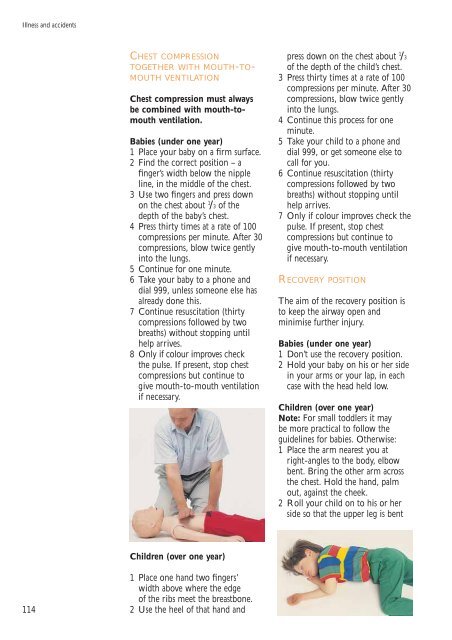Here - Health Promotion Agency
Here - Health Promotion Agency
Here - Health Promotion Agency
You also want an ePaper? Increase the reach of your titles
YUMPU automatically turns print PDFs into web optimized ePapers that Google loves.
Illness and accidents<br />
CHEST COMPRESSION<br />
TOGETHER WITH MOUTH-TO-<br />
MOUTH VENTILATION<br />
Chest compression must always<br />
be combined with mouth-tomouth<br />
ventilation.<br />
Babies (under one year)<br />
1 Place your baby on a firm surface.<br />
2 Find the correct position – a<br />
finger’s width below the nipple<br />
line, in the middle of the chest.<br />
3 Use two fingers and press down<br />
on the chest about 1 /3 of the<br />
depth of the baby’s chest.<br />
4 Press thirty times at a rate of 100<br />
compressions per minute. After 30<br />
compressions, blow twice gently<br />
into the lungs.<br />
5 Continue for one minute.<br />
6 Take your baby to a phone and<br />
dial 999, unless someone else has<br />
already done this.<br />
7 Continue resuscitation (thirty<br />
compressions followed by two<br />
breaths) without stopping until<br />
help arrives.<br />
8 Only if colour improves check<br />
the pulse. If present, stop chest<br />
compressions but continue to<br />
give mouth-to-mouth ventilation<br />
if necessary.<br />
press down on the chest about 1 /3<br />
of the depth of the child’s chest.<br />
3 Press thirty times at a rate of 100<br />
compressions per minute. After 30<br />
compressions, blow twice gently<br />
into the lungs.<br />
4 Continue this process for one<br />
minute.<br />
5 Take your child to a phone and<br />
dial 999, or get someone else to<br />
call for you.<br />
6 Continue resuscitation (thirty<br />
compressions followed by two<br />
breaths) without stopping until<br />
help arrives.<br />
7 Only if colour improves check the<br />
pulse. If present, stop chest<br />
compressions but continue to<br />
give mouth-to-mouth ventilation<br />
if necessary.<br />
RECOVERY POSITION<br />
The aim of the recovery position is<br />
to keep the airway open and<br />
minimise further injury.<br />
Babies (under one year)<br />
1 Don’t use the recovery position.<br />
2 Hold your baby on his or her side<br />
in your arms or your lap, in each<br />
case with the head held low.<br />
Children (over one year)<br />
Note: For small toddlers it may<br />
be more practical to follow the<br />
guidelines for babies. Otherwise:<br />
1 Place the arm nearest you at<br />
right-angles to the body, elbow<br />
bent. Bring the other arm across<br />
the chest. Hold the hand, palm<br />
out, against the cheek.<br />
2 Roll your child on to his or her<br />
side so that the upper leg is bent<br />
Children (over one year)<br />
114<br />
1 Place one hand two fingers’<br />
width above where the edge<br />
of the ribs meet the breastbone.<br />
2 Use the heel of that hand and

















